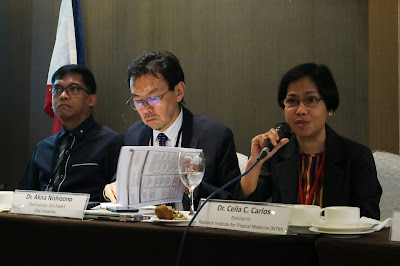JAPOHR project 2nd JCC was held on February 11, 2020, at The Bayleaf Intramuros. The event was well attended by important stakeholders involved in the project. It was a successful event where the participants and collaborators got information from the reports presented.

Ms. Patricia Ann Alvaro of the Provincial Health Office of Bulacan played MC.
First speaker was the Chairperson, Dr. Myrna Cabotaje, the Undersecretary of Health (Public Health Services Team). She made lively opening remarks, recognizing the presence of all departments involved. She announced support of the project good intentions. Opening remarks are then followed by Dr. Nishizono, Chief Advisor who discussed the outline of the JAPOHR project.
 |
| Dr, Myrna Cabotaje on her Opening Remarks |
 |
| Dr. Nishizono on his presentation |
On behalf of Ms. Ayumu Ohshima, Senior Representative of JICA Philippinesr, Ms. Flerida Chan, Senior Chief of JICA Philippines represented her to do also the welcome remarks.
 |
| Ms. Flerida Chan |
The overall progress was presented by the Project Manager, Dr. Beatriz P. Quiambao who is now the OIC-Assistant Director of RITM.
 |
| Dr. Beatriz Quiambao presenting the overall progress of the project |
Dr. Milagros Mananggit of the Integrated Laboratory Division of RADDL3 discussed briefly the review of progress. She explained the progress of Output 1-1 (animal rabies diagnosis)
Dr. Sheila Esposo of the Histopathology Section of RITM presented the histopathological
analysis for rabid dog.
Dr. Nobuo Saito's presentation is about human rabies diagnosis. He explained the Biomarker survey at Oita University and the Systematic sample collection in SLH. (Output 1-2 human rabies diagnosis)
 |
| Dr. Nobuo Saito, JICA Expert |
The Provincial Veterinary Officer, Dr. Voltaire Basinang of The Provincial Government of Bulacan explained the progress of activities in Bulacan.
 |
| Dr. Voltaire Basinang from PVO, Bulacan |
The Rabies Data Share System (RaDSS) was discussed by Dr. Daphne Jorca, the Project Co-Manager. The framework and the process of how it works was explained.
 |
| Dr. Daphne Jorca of DA-BAI |
The part of Dr. Timothy John Dizon of the Medical Department of RITM was about the Community Study with details on KP (Knowledge and Practices) and Dog Ecology Study.
 |
| Dr. Timothy John Dizon |
Mr.. Koji Shimokawa presented the project major inputs. Topics were the training course in Japan; technical support personnel; laboratory and IT equipment; and the JICA local budget expenditure.
 |
| Mr. Koji Shimokawa, the Project Coordinator |
One of the collaborators who went to Japan for training was Ms, Gina Manlapig. her report was about the training of a molecular epidemiological study for measures against rabies under JAPOHR project.
 |
| Ms. Gina Manlapig of DOH-RFO3 |
Another part of Dr. Nobuo Saito was about the proposed modification of the PDM (Project Design Matrix) and R/D (records of Discussion). Dr. Akira Nishizono also explained the proposed plan of activities for 2020. During the discussion part, attendees actively asked questions and was given answers directly. Discussion and approval facilitated by Dr. Leda Hernandez where the project gets the approval on some amendments.
The informative meeting was a success! Closing the event was made by the RITM Director, Dr. Celia C. Carlos. The director congratulated all for the efforts done. She thanks everyone who actively collaborating for the success of the project. While she hopes to more fruitful activities that will benefit not only animals but also humans. She wishes everybody good luck.
 |
| Closing Remarks by RITM Director, Dr. Celia C. Carlos |
This is the group photo! All happy faces and positive to the more activities to happen in the future for the success of the project! All is woking AS ONE just like the project suggests ONE HEALTH approach!

















